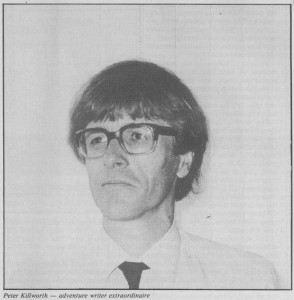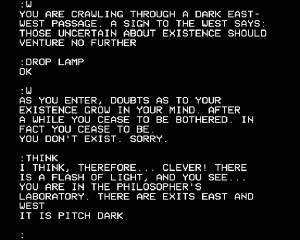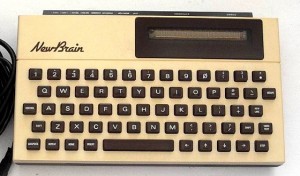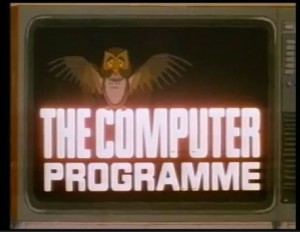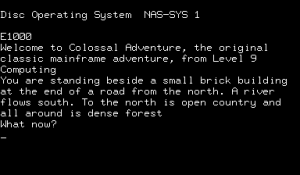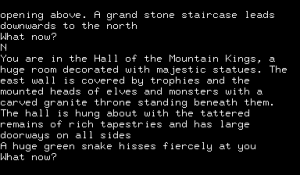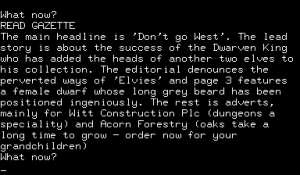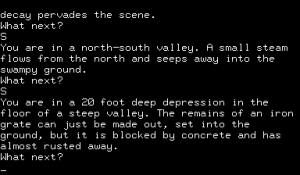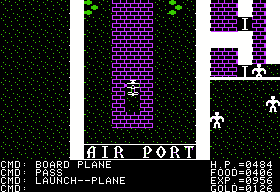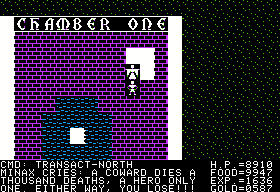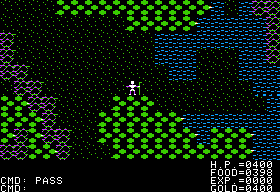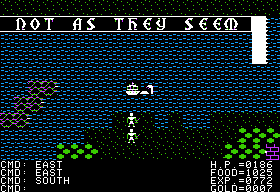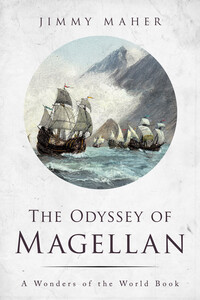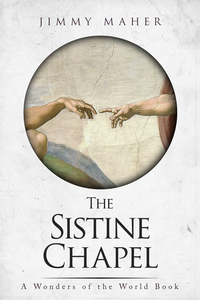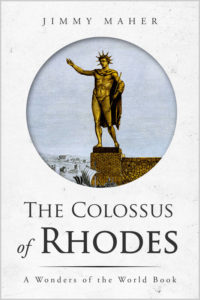Cambridge was the heart of the early British PC industry, home of both Sinclair and Acorn as well as many supporting and competing concerns. Indeed, Cambridge University can boast of some of the major achievements in computing history, to such an extent that easy characterizations of the university as “the MIT of Britain” or the town as “the Silicon Valley of the UK” seem slightly condescending. It was Cambridge that nurtured Alan Turing, the most important thinker in the history of computer science, and that supplied much of the talent (Turing among them) to the World War II code-breaking effort at Bletchley Park that laid the foundation for the modern computer. Most spectacularly of all, it was at Cambridge in 1949 that EDSAC-1 — the first stored-program fully electronic computer, meaning the first that could be programmed the way we understand that term today — first came online. (The earlier American ENIAC was programmable only by switching logic gates and rerouting cabling in an elaborate game of Mouse Trap that could consume weeks. At risk of wading into a debate that has swirled for years, there’s a real argument to be made that EDSAC-1 was the first real computer in the sense of being something that operated reasonably akin to what we mean when we use the term today.) In 1953 Cambridge became the first university to recognize computer science as a taught discipline.
For decades computing in and around Cambridge centered on whatever colossus was currently installed in the bowels of the Computing Laboratory. After EDSAC-1 came EDSAC-2 in 1958, which was in turned replaced by Titan in 1964. All of these had been essentially one-off, custom-built machines constructed by the university itself in cooperation with various British technology companies. It must therefore have seemed a dismaying sign of the changing times when the university elected to buy its next big mainframe off the shelf, as it were — and from an American company at that. Coming online in February of 1973, Phoenix — the name was meant to evoke a phoenix rising from the ashes of the newly decommissioned Titan — was a big IBM 370 mainframe of the sort found in major companies all over the world. However, just as the hackers at MIT had made their DEC machines their own by writing their own operating systems and tools from scratch, those at Cambridge replaced most of IBM’s standard software with new programs of their own. Thus Phoenix became, literally, a computing environment like no other.
For more than two decades Phoenix was a central fixture of life at Cambridge. (In hardware terms, there were actually three Phoenixes; newer IBM mainframes replaced older hardware in 1982 and 1989.) It was used for the expected computer-science research, much of it groundbreaking. But it also, like the contemporary American PLATO, became a social gathering place. It provided email access to a whole generation of students along with lively public discussion boards. The administrators delighted in replacing the stodginess of IBM’s standard MVS operating system with their own quirky sensibility. Phoenix’s responses to various pleas for HELP are particularly remembered.
HELP SEX
Phoenix/MVS, being of essentially neuter gender, cannot help with emotional, personal or physical human problems
HELP GOD
Please appeal to deities directly, not via Phoenix/MVS
HELP PHEONIX
Pheonix is spelt Phoenix and pronounced Feenicks.
HELP CS
CS is a standard abbreviation for Computing Service; it is also a "gas" used for riot control.
Given this freewheeling atmosphere, you’d expect to find plenty of games on Phoenix as well. And you wouldn’t be disappointed. Phoenix had all the usual suspects, from card games to chess to an implementation of Scrabble with an impressively fiendish AI opponent to play against. And, beginning in the late 1970s, there were also adventures.
Both Crowther and Woods’s Adventure and Zork (in its Dungeon incarnation, as “liberated” from MIT by Bob Supnik and ported to FORTRAN) arrived at Cambridge as one of their first destinations outside the United States. Like hackers across the U.S. and, soon enough, the world, those at Cambridge went crazy over the games. And also like so many of their American counterparts, they had no sooner finished playing them than they started speculating about writing their own. In 1978 John Thackray and David Seal, two Cambridge graduate students, started working on a grand underground treasure hunt called Acheton. It’s often claimed that Acheton represents just the third adventure game ever created, after Adventure itself and Zork. That’s a very difficult claim to substantiate in light of the number of people who were tinkering with adventures in various places in the much less interconnected institutional computing world of the late 1970s. Amongst just the finished, documented games, Mystery Mansion and Stuga have at least as strong a claim to the title of third as Acheton. Still, Acheton was a very early effort, almost certainly the first of its kind in Britain. And it was also a first in another respect.
Looking at the problem of writing an adventure game, Thackray and Seal decided that the best approach would be to create a new, domain-specific programming language before writing Acheton proper. The result, which has been retroactively dubbed T/SAL (“Thackray/Seal Adventure Language”) today, but was simply known as “that language on Phoenix used to write adventures” during its heyday at Cambridge, represents the first ever specialized adventure programming language. (Even the PDP-10 Zork had been written in the already extant, if unusually text-adventure-suitable, MDL.) The T/SAL system is something of a hybrid between the database-driven design of Scott Adams and the more flexible fully programmable virtual machine of Infocom. Objects, rooms, and other elements are defined as static database elements, but the designer can also make use of “programs,” routines written in an interpreted, vaguely BASIC-like language that let her implement all sorts of custom behaviors. Thackray and Seal improved T/SAL steadily as dictated by the needs of their own game in progress, always leaving it available for anyone else who might want to give adventure writing a shot. Meanwhile they also continued to work on Acheton, soon with the aid of a third partner, a PhD candidate in mathematics named Jonathan Partington. It grew into a real monster: more than 400 rooms in the final form it reached by about 1980, thus dwarfing even Zork in size and still qualifying today, at least in terms of sheer geographical scope, as one of the largest text adventures ever created.
Yet the most important outcome of the Acheton project was T/SAL and the community it spawned. The system was used to create at least fourteen more games over a decade. Freed as they were by virtue of running on a big mainframe from the memory restrictions of contemporary PC adventures, designers could craft big, sometimes surprisingly intricate playgrounds for a brainy audience of budding mathematicians and scientists that reveled in the toughest of puzzles. For those on their wavelength, they became an indelible part of their student memories. Graham Nelson, easily the most important figure in interactive fiction of the post-Infocom era, was an undergraduate at Cambridge during the heyday of the Phoenix games. He writes in Proustian terms of his own memories of the games: “They [the Phoenix games] are as redolent of late nights in the User Area as the soapy taste of Nestlé’s vending machine chocolate or floppy, rapidly-yellowing line printer paper.” Nelson’s later puzzle-filled epics Curses and Jigsaw show the influence of these early experiences at Cambridge in their erudition and sprawl.
Yet we shouldn’t overestimate the popularity of the Phoenix games. Running under a custom operating system on an IBM design that was seldom open to fun and games at other installations, they had no chance to spread beyond Cambridge in their original incarnations. Even at the university, their sheer, unapologetic difficulty made them something of a niche interest. And authoring new games in the rather cryptic T/SAL required an especial dedication. Fifteen games in over ten years is not really a huge number, and most of those were front-loaded into the excitement that surrounded the arrival of Adventure and the novelty of Acheton. During most years of the mid- and late 1980s it was only Jonathan Partington, who in authoring or co-authoring no fewer than eight of the fifteen games was by far the most prolific and dedicated of the T/SAL authors, that continued to actively create new work with the system. It’s probably safe to say that most of the Phoenix games had (at best) hundreds rather than thousands of serious players. Still, they would have a larger impact on the British adventuring scene outside of Cambridge’s ivory tower in a different, commercialized form.
One of the first at Cambridge to pick up on the T/SAL system was an oceanography professor in his early thirties named Peter Killworth, who had been taught a healthy appreciation for the brave new world of possibility that Adventure represented by his seven- and three-year-old sons: “I was constrained by what I knew about computers, but they treated the terminal as a person. While I was trying to work out what an axe was doing in a computer program, they were chopping the nearest tree down.” Killworth was intrigued enough to start tinkering with T/SAL as soon as he noticed it. He wrote a simple physics problem using the language. Through it he got his introduction to the interconnected web of social problem-solving that made the experience of playing and writing early institutional adventures so different from those on PCs.
“I had a problem which revolved around using a pivot to get up a cliff. Put weight on one end, and the other goes up — but you have to be careful to get the weight right. I programmed it on the mainframe, and left it for a friend to have a look at. When I came back next morning, I was deluged with messages from people I’d never heard of, all telling me where I’d gone wrong in the program.”
Encouraged by all this interest, Killworth decided to make a full-fledged game to house the puzzle. The result, which he completed even before Acheton was done, he called Brand X. It was a treasure hunt fairly typical of the general Phoenix aesthetic in its cruel puzzles and relatively heady (by adventure-game standards) allusions to Descartes, Coleridge, and the Bible. Figuring that was that, Killworth then returned his full attention to oceanography — until the arrival of the BBC Micro and Acornsoft caused him to start thinking about his game again a couple of years later.
Of all the technology companies in and around Cambridge, Acorn worked hardest to foster ties with the university itself. Chris Curry and Hermann Hauser made the most of the connections Hauser had formed there during the years he spent as a Cambridge PhD candidate. With Acorn’s office located literally just around the corner from the Computing Laboratory, the two had ample opportunity to roam the corridors sniffing out the best and the brightest to bring in for their own projects. They considered Cambridge something of a secret weapon for Acorn, taking the university itself into their confidence and making it almost a business partner. Cambridge reciprocated by taking Acorn’s side almost en masse as the British computer wars of the 1980s heated up. The university grew to consider the BBC Micro to be the machine that they had built — and not without cause, given the number of Cambridge students and graduates on Acorn’s staff. Clive Sinclair, meanwhile, who like Chris Curry had not attended university, displayed only a grudging respect for the Cambridge talent, mingled with occasional expressions of contempt that rather smack of insecurity.
Acorn Computers had helped one David Johnson-Davis to set up a software publisher specializing in software for their first popular machine, the Atom, in 1980. Now, as the BBC Micro neared launch, Acornsoft would prove to be a valuable tool to advance the goal of making as much software as possible, and hopefully of as high a quality as possible, available for the new machine. Just as their big brothers had in designing the BBC Micro’s hardware, Acornsoft turned to the university — where prototypes were floating around even before the machine’s official launch — for help finding quality software of all types. They offered prospective programmers a brand new BBC Micro of their own as a sort of signing bonus upon acceptance of a program. After a friend got a statistics package accepted, Peter Killworth started to ponder whether he had something to give them; naturally, his thoughts turned to Brand X. He rewrote the game in the relatively advanced BBC BASIC, using every technique he could devise to save memory and, when that failed, simply jettisoning much of the original. (Ironically, the physics problem that got the whole ball rolling was one of those that didn’t make the final cut.) He then presented it to Acornsoft, who agreed to publish it under the title of Philosopher’s Quest, a tribute to the game’s intellectual tone proposed by Johnson-Davis’s right-hand man Chris Jordan. It was published in mid-1982, the first game in the Acornsoft line. Killworth hoped it would sell at least 500 copies or so and earn him a little bit of extra pocket money; in the end it sold more than 20,000.
Even in its chopped-down microcomputer incarnation, Philosopher’s Quest provides a pretty good introduction to the Phoenix aesthetic as a whole. An unabashed treasure hunt with no pretensions toward narrative or mimesis, its geography simply serves as the intellectual landscape to house its puzzles. To understand the game’s level of commitment to physical reality, consider that, after swimming underwater for a while, you can still strike a match inside the whale that swallows you. (Don’t ask.) We’re a long way from Zork III and its realistic simulation of the effects of swimming in a lake on a battery-powered lantern.
Yet the writing is as solid as it can be within the constraints of 32 K, with occasional flashes of dry wit and an awareness of culture beyond Dungeons and Dragons and Star Wars that’s pretty rare amongst games of its era. The parser is the typical two-worder of the era, but the game doesn’t strain to push beyond its limits, so it only occasionally frustrates. While not huge, the game is amazingly large given the memory restrictions under which Killworth was operating and the fact that he was working in BASIC. He was already an experienced programmer of weather and ocean simulations thanks to his day job, and his expertise comes through here. He would later speak of an “unofficial competition” with the Austin brothers of Level 9, kings of text compression, over how much text they could cram into the minuscule amounts of memory they had to work with.
The puzzles are a mixed bag, sometimes brilliant but always heartless. The very beginning of the game tells you everything you need to know about what you’re in for. You start in a store from which you can only remove two out of four items. You can increase this number to three through a clever action, but there’s no way to know which one of the four you’re not going to need later in the game; trial and error and learning by death are the rules of the day here. Still, some of the puzzles border on the beautiful, including one of my favorite guess-the-verb puzzles of all time. (Yes, like much in the game this puzzle violates the Player’s Bill of Rights in depending on outside knowledge, but, atrocities like Zork II‘s baseball maze aside, this has always struck me as the least of adventure-game design sins, especially in this era of readily accessible information on virtually any subject. I rather like it when a game sends me scurrying to the Internet in search of outside knowledge to apply. And I feel really special when, as in this case, I already have the knowledge I need.)
Other puzzles, however, are cheap and unforgivable in that way all too typical of early text adventures. There’s a vital room exit that goes completely un-described and thus can be sussed out only by beating your head against every wall in every room when you’ve reached the point of total frustration. More than anything else, the game takes delight in killing you, a parade of gruesome if often clever deaths, most of which you’re going to experience at least once in the course of playing; these are not jumping-off-a-cliff-to-see-what-happens deaths, but rather innocently-entering-a-room-only-to-be-trampled-by-an-elephant deaths. The deaths are so numerous and so absurd that they almost come off as parody. More so even than many other old games, Philosopher’s Quest can be enjoyed today, but only if you can get yourself in tune with its old-school sensibilities. Unsurprisingly, it and the other Phoenix games are very polarizing these days. Graham Nelson among others remains a big fan, while still others find them an exercise in masochism; see this old newsgroup thread for a sample of typical reactions.
Peter Killworth continued to write adventures after Philosopher’s Quest, for Acornsoft and later Topologika (who also published quite a few of the other Phoenix games for PCs). Already by 1983 he was earning twice as much from his games as he did from his Cambridge professorship. He later dismissed Philosopher’s Quest and its sometimes arbitrary puzzles as something of a learning exercise, but he always retained his reputation as an author of difficult games. For Killworth’s follow-up to Philosopher’s Quest, Castle of Riddles, Johnson-Davis had an idea that would begin something of a tradition in the British adventure-gaming scene. Acornsoft and Your Computer magazine sponsored a contest with a prize of £1500 worth of Acorn hardware and a £700 silver ring to the first person to solve the game. It took winner Peter Voke, Britain’s equivalent of the American adventure-gaming machine Roe R. Adams III, a full eight hours to solve the game. (Runner-up Colin Bignell made a mad cross-country dash through the night to get his winning entry to Your Computer, but pulled up in his car in front of the magazine’s headquarters just 20 minutes behind Voke.) Killworth also authored one of the classics of the sub-genre of adventure-authoring guides that were popular in the early and mid-1980s, the aptly titled How to Write Adventure Games. He died in 2008 of motor neuron disease. Even when he was earning more from his adventures than he was from his day job, games were just a sideline to a significant career in oceanographic research.
We’ll likely be revisiting some of the later works of Killworth and the other Phoenix authors at some point down the road a bit. For now, you can download Philosopher’s Quest and Castle of Riddles as BBC Micro disk images. (I recommend Dave Gilbert’s superb BeebEm emulator.) Most of the original incarnations of the Phoenix games, Brand X included, have been ported to Z-Code format, playable in my own Filfre and countless other interpreters, thanks to a preservation effort led by Graham Nelson, Adam Atkinson, and David Kinder following the final shutdown of Phoenix in 1995.

